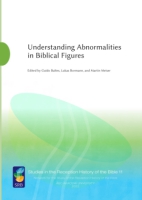
Understanding Abnormalities in Biblical Figures
Edited by Guido Baltes, Lukas Bormann, and Martin Meiser
Understanding Abnormalities in Biblical Figures
Edited by Guido Baltes, Lukas Bormann, and Martin Meiser
In the Bible and its environment there are frequent references to the extraordinary states of mind of Biblical figures: Adam, Abraham, David, Deborah, Delilah, Samson, Saul and many others. Based on Hebrew anthropology, the texts of Second Temple Judaism and the New Testament reflect the question: How do human beings and the mind relate to one another? Influenced by the anthropology of the great philosophical schools of Platonism, Aristotelianism, and Stoicism, the idea that humankind is best understood anthropologically within the framework of a body-soul dichotomy or a body-soul-spirit/mind trichotomy was also gaining a foothold in Judaism. Church fathers predominantly assume that the biblical heroes integrated by God into the history of salvation are also models of morality, they are particularly challenged by the texts in which deviant behavior is described. The question thus also opens up an ethical dimension to the history of biblical reception.
- Description
- Bio
- Sample Chapters
- Subjects
Fifteen scholars examine the tension between normality and deviance in the Hebrew Bible and the New Testament as well as in their reception in Second Temple Judaism and patristic literature. It becomes clear that the ideas expressed in these texts about deviant behavior are primarily influenced by changes in anthropological and theological assumptions. The authors adapt the tradition to the contemporary understanding of normality and deviance to reach their rhetorical aim to convince the reader about their interpretations of the Biblical figures.
Guido Baltes is Adjunct Professor of New Testament at the University of Marburg.
Lukas Bormann is Professor of New Testament at the Uniersity of Marburg.
Martin Meiser is apl. Professor (retired) at Saarland University.
Also of Interest
Mailing List
Subscribe to our mailing list and be notified about new titles, journals and catalogs.






